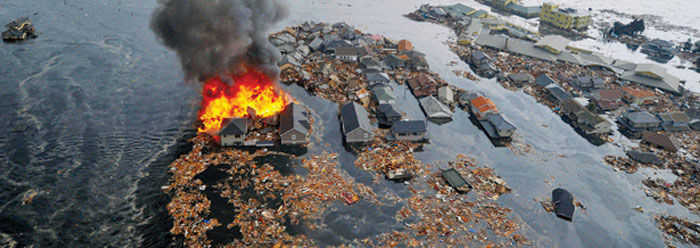The March 11 offshore 9.0-scale earthquake pushed a massive surge of water over Japan that decimated large areas of its coast and killed thousands of inhabitants. The human toll is not yet fully known, but amidst this devastating tragedy lie lessons about the power of earth and water.
British lawyer Charles Lyell popularized the phrase "the present is the key to the past" in his 1830 work Principles of Geology. In it, he argued that everyday natural processes, such as daily erosion, can account for the formation of earth's land features. Since then, many geologists have come to recognize that his Enlightenment-era maxim is flawed and that earth features like rock formations and steep-sided mountains instead resulted from catastrophes. Thus, perhaps natural disasters are the key to the past.
If catastrophes are key, then it is instructive to consider the destruction wrought on Japan from so relatively small an earthquake. Much larger quakes certainly occurred in the past, causing devastation on much larger scales. This is known from both geology and the biblical record.
For example, geologists are now talking about metamorphosed rocks bordering ancient fault lines that were caused by "megaquakes" that left behind "superfaults." The superfaults caused so much friction that they melted the rock on either side of the faults, where the rocks rubbed together.1 Today's earthquakes, which occur along fault lines, are not nearly this powerful.
Biblically, superfaults follow from the statement that "all the fountains of the great deep [were] broken up" at the start of the global Flood of Noah's day.2 Geologist Andrew Snelling commented on the likely effects of such an event in the second volume of his book Earth's Catastrophic Past:
[Genesis 7:11] appears to suggest that the cleaving open of the earth not only involved the release of water and steam, but also the release of magmas (molten rock) through great volcanic explosions and eruptions….Similarly, where cleaving of the earth's crust occurred on land, there would also have been volcanic eruptions accompanied by vast outpourings of lavas. Furthermore, it is entirely reasonable to make comparisons with the phenomena associated with volcanism today, and therefore to expect that there must have also been great earthquakes and tsunamis (popularly known as tidal waves) generated by this explosive volcanic activity around the globe during the Flood.3
If one relatively small earthquake-generated tsunami could cause this much damage in Japan, how much more damage would be caused by the barrage of tsunamis generated by continuous, worldwide earthquakes during the year-long Flood of Noah that left earth-scars now called "superfaults"? It would certainly be enough to corroborate the Bible's account of a monumental cataclysm through which "the world that then was, being overflowed with water, perished."4
References
- Magloughlin, J. F. 2007. Paleonanoquakes through Paleomegaquakes—Friction Melting Features within Fault Zones across Five Orders of Magnitude in Thickness. Geological Society of America Abstracts with Programs. 39 (6): 374. Paper presented at the GSA Denver Annual Meeting, October 30, 2007.
- Genesis 7:11, emphasis added.
- Snelling, A. 2009. Earth's Catastrophic Past. Dallas, TX: Institute for Creation Research, 474.
- 2 Peter 3:6.
* Mr. Thomas is Science Writer at the Institute for Creation Research.
